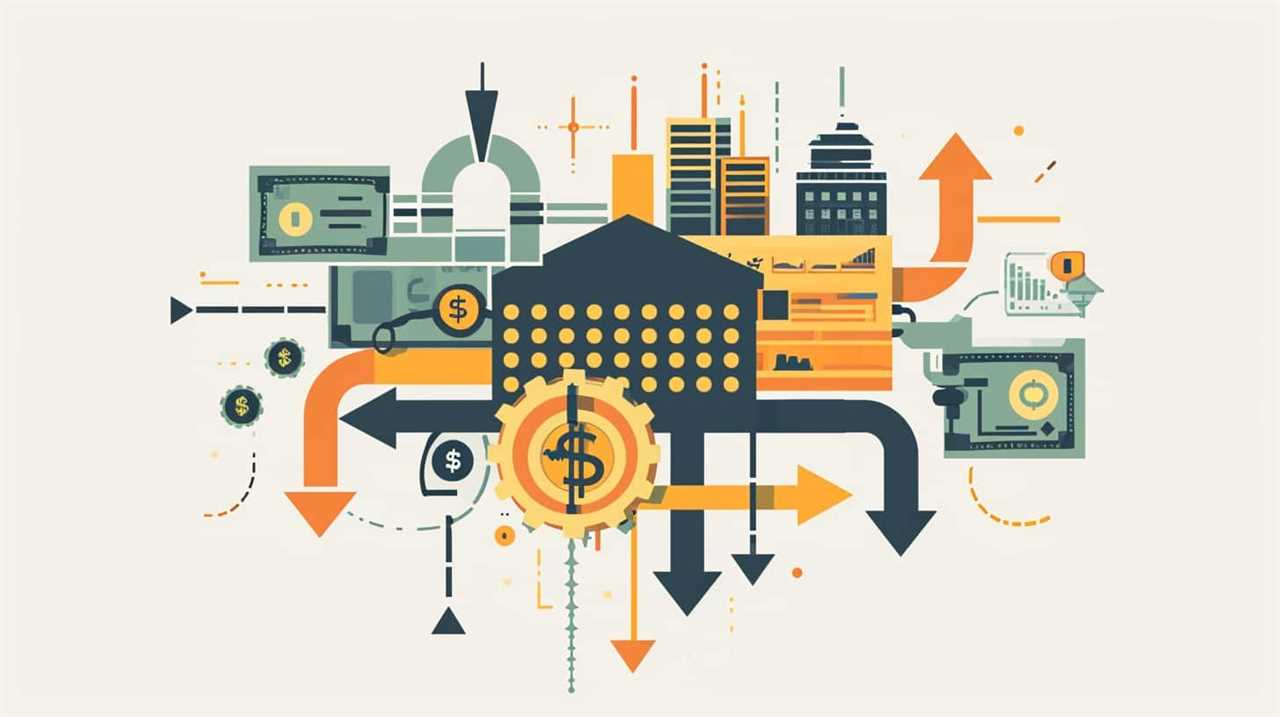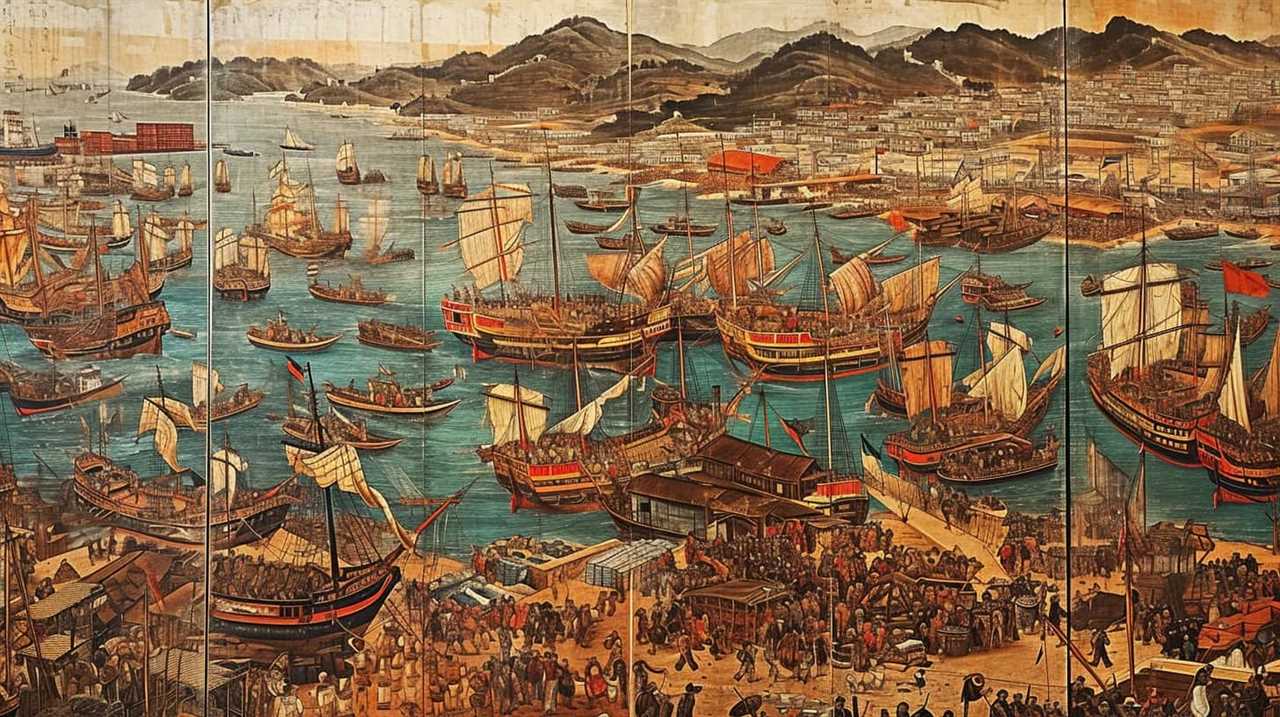We happened to come across the insightful teachings of Milton Friedman, a well-known economist who was a strong advocate for monetarism and economic stability. His quotes act as catalysts for new ideas, inspiring us to challenge conventional economic theories.
As we delve into his insights, we uncover the pivotal role of money supply in shaping our economy. Friedman’s belief that inflation is a monetary phenomenon challenges the status quo, while his emphasis on controlling money growth highlights the importance of stability.
Through his Quantity Theory of Money, Friedman unveils the interconnectedness of money and economic growth. Join us as we explore his thoughts on the costs of inflation, the benefits of price stability, and the role of government in monetary policy.
Get ready to embark on a journey of intellectual curiosity and innovative thinking with Milton Friedman’s enlightening quotes.

Key Takeaways
- Money supply management is crucial for maintaining economic stability and preventing financial crises.
- Changes in the money supply can impact exchange rates, affecting the competitiveness of exports.
- Inflation is primarily a result of money supply dynamics, with excessive growth leading to inflationary pressures.
- Monetary policy, including the management of money supply, plays a significant role in promoting economic stability, growth, and maintaining stable prices.
The Role of Money Supply
The role of the money supply is crucial in understanding the impact of monetary policy on economic stability. Money supply refers to the total amount of money circulating within an economy, including cash, demand deposits, and other forms of money. It plays a significant role in shaping the overall economic conditions and can have a profound impact on financial crises and exchange rates.
Firstly, the money supply is closely linked to financial crises. An excessive increase in the money supply can lead to inflationary pressures, which can destabilize an economy and trigger financial crises. On the other hand, a sudden contraction in the money supply can lead to deflationary pressures, causing a decline in economic activity and exacerbating financial instability. Therefore, maintaining an appropriate level of money supply is crucial for preventing and managing financial crises.
Secondly, the money supply also affects exchange rates. Changes in the money supply can impact the value of a currency relative to other currencies. An increase in the money supply can lead to a depreciation of the currency, making exports more competitive and imports more expensive. Conversely, a decrease in the money supply can strengthen the currency, making exports more expensive and imports cheaper. Understanding the relationship between money supply and exchange rates is essential for policymakers and businesses operating in global markets.
Inflation as a Monetary Phenomenon
Now, let’s delve into the subtopic of ‘Inflation as a Monetary Phenomenon’ by examining the frequency with which inflation occurs and its impact on the economy.

Inflation, as Milton Friedman argued, is primarily a result of money supply dynamics. When the money supply grows faster than the rate of economic output, this excess liquidity can lead to higher prices and inflationary pressures. On the other hand, if the money supply grows at a slower rate than economic output, this can result in deflationary pressures.
Inflation targeting has emerged as a popular monetary policy framework in recent years. Central banks set specific inflation targets and adjust the money supply accordingly to achieve those targets. By focusing on inflation as the primary objective, policymakers aim to maintain price stability and anchor inflation expectations.
The impact of inflation on the economy can be far-reaching. High and unpredictable inflation erodes the purchasing power of consumers, lowers real wages, and distorts resource allocation. It also creates uncertainty, causing businesses to hesitate in making long-term investment decisions. Conversely, low and stable inflation is conducive to economic growth and stability, fostering a favorable business environment and encouraging long-term investments.
Understanding the link between money supply dynamics and inflation is crucial for policymakers and economists alike. By carefully managing the money supply and adopting effective inflation targeting strategies, economies can maintain price stability and promote sustainable economic growth.

Money Supply and Economic Stability
Our understanding of economic stability and its relationship to the money supply is enhanced by Milton Friedman’s insights on monetarism. According to Friedman, the management of the money supply plays a crucial role in maintaining economic stability. He argued that excessively rapid growth in the money supply leads to inflation, while a slow or stagnant growth in the money supply results in deflation.
Friedman’s analysis suggests that the impact of money supply management extends beyond inflation and deflation. It also affects interest rates, which in turn influence investment and consumption decisions. When the money supply is expanded rapidly, interest rates tend to rise as demand for credit increases. This may discourage borrowing and investment, leading to a slowdown in economic activity. Conversely, a contractionary monetary policy, characterized by a slow growth in the money supply, can lead to lower interest rates and stimulate borrowing and investment.
Understanding the relationship between the money supply and economic stability allows policymakers to make informed decisions regarding monetary policy. By managing the money supply effectively, policymakers can control inflation, promote stable economic growth, and influence interest rates to encourage investment and consumption. Friedman’s insights on monetarism provide valuable guidance in achieving these goals and maintaining a stable and innovative economic environment.
The Quantity Theory of Money
The Quantity Theory of Money explores the relationship between the money supply and its impact on the economy.

It suggests that an increase in the money supply leads to inflation, as more money chases the same amount of goods and services.
This theory also posits that changes in the money supply have a direct effect on economic growth, as excessive money creation can distort market signals and hinder productive investment.
Money Supply and Inflation
We believe that understanding the relationship between money supply and inflation is crucial for achieving economic stability.
Money supply management plays a significant role in controlling inflation. According to the Quantity Theory of Money, there’s a direct relationship between the money supply and the price level in an economy.

When the money supply increases faster than the growth rate of goods and services, it leads to an increase in aggregate demand and, subsequently, inflation. On the other hand, if the money supply grows slower than the growth rate of goods and services, it can lead to deflation.
Therefore, policymakers must carefully manage the money supply to maintain price stability and avoid excessive inflation or deflation.
This understanding helps us innovate and develop effective strategies for inflation control, promoting economic stability and growth.
Impact on Economic Growth
One key aspect of the Quantity Theory of Money is its impact on economic growth. Understanding this impact is crucial for policymakers and economists who seek to create innovative strategies for sustainable growth.

Here are four important points to consider:
- Government intervention: The Quantity Theory of Money suggests that excessive government intervention in the money supply can lead to inflation and hinder economic growth. By focusing on stable monetary policies, governments can create an environment conducive to innovation and investment.
- Monetary policy effectiveness: The theory highlights the importance of effective monetary policy in promoting economic growth. By adjusting the money supply in line with the needs of the economy, policymakers can strive to maintain price stability and encourage long-term growth.
- Inflationary pressures: If the money supply grows faster than the real economy, it can lead to inflationary pressures that can hinder economic growth. Keeping a balance between money supply growth and the growth of the real economy is crucial for sustainable development.
- Investor confidence: The Quantity Theory of Money suggests that maintaining a stable money supply can enhance investor confidence. This confidence can drive innovation and investment, leading to higher economic growth and prosperity.
Controlling Money Growth
Regularly monitoring and regulating the rate of money growth is essential for maintaining economic stability, as emphasized by Milton Friedman. Money supply management plays a crucial role in controlling money growth and ensuring that it aligns with the needs of the economy. By implementing effective monetary policy, policymakers can influence the money supply and its growth rate.
One way to achieve this is through open market operations, where the central bank buys or sells government securities to adjust the money supply. This allows the central bank to inject or withdraw money from the economy, thus influencing its growth. Additionally, reserve requirements can be adjusted to control the amount of money that banks can lend, affecting the overall money supply.
To illustrate the importance of controlling money growth, consider the following table:

| Monetary Policy Action | Impact on Money Growth |
|---|---|
| Increase in open market purchases | Expansionary |
| Decrease in reserve requirements | Expansionary |
| Increase in interest rates | Contractionary |
| Decrease in open market purchases | Contractionary |
| Increase in reserve requirements | Contractionary |
The Dangers of Excessive Money Supply
Controlling money growth is crucial for maintaining economic stability, and excessive money supply poses significant dangers. Here are four reasons why the dangers of excessive money supply should be taken seriously:
- Inflation: When there’s an excessive increase in the money supply, it can lead to inflation. This erodes the purchasing power of individuals and reduces the value of money. As prices rise, people’s savings and investments lose their value, creating uncertainty and hindering economic growth.
- Misallocation of resources: Excessive money supply can distort the allocation of resources in an economy. When there’s more money in circulation, it can lead to artificial demand for goods and services. This can result in misallocations of resources, as businesses may invest in sectors that aren’t sustainable in the long run.
- Boom and bust cycles: Excessive money supply can contribute to boom and bust cycles in the economy. When there’s a rapid expansion of the money supply, it can create an artificial economic boom. However, this boom is often followed by a bust, as the underlying fundamentals of the economy can’t sustain such growth.
- Loss of confidence: Excessive money supply can lead to a loss of confidence in the currency and the overall economy. When people see that the money supply is growing at an unsustainable rate, they may start to doubt the stability of the currency. This can lead to capital flight, currency devaluation, and a decline in foreign investment.
The Impact of Monetary Policy
Why is it important to understand the impact of monetary policy on economic stability?
Understanding the impact of monetary policy is crucial because it allows us to comprehend how changes in interest rates and the money supply affect various aspects of the economy, such as employment.
Monetary policy, which is controlled by central banks, influences interest rates through the manipulation of the money supply. By adjusting interest rates, central banks can encourage or discourage borrowing and spending, which in turn affects investment and employment levels.

When central banks lower interest rates, borrowing becomes cheaper, which encourages businesses to invest and expand, leading to increased employment opportunities. On the other hand, when interest rates are raised, borrowing becomes more expensive, reducing business investment and potentially leading to a decrease in employment.
Therefore, understanding the impact of monetary policy on employment is crucial for policymakers and economists in order to make informed decisions that promote economic stability and growth.
In the subsequent section, we’ll discuss the importance of stable prices and how monetary policy plays a role in achieving this goal.
The Importance of Stable Prices
To achieve economic stability, it’s imperative to maintain stable prices throughout the economy. Stable prices have a significant impact on consumers and play a crucial role in fostering investment. Here are four reasons why stable prices are essential:

- Protecting consumers’ purchasing power: Inflation erodes the value of money over time, reducing consumers’ ability to buy goods and services. By maintaining stable prices, we ensure that consumers’ purchasing power remains intact, allowing them to make confident and informed economic decisions.
- Encouraging long-term investment: Stable prices provide businesses with a predictable environment for planning and investment. When prices are stable, businesses can accurately assess costs, make informed investment decisions, and pursue long-term growth strategies. This stability promotes innovation and economic development.
- Reducing uncertainty and risk: Inflation introduces uncertainty and risk into the economy, making it difficult for businesses and individuals to plan for the future. Stable prices reduce this uncertainty, fostering confidence and stability in the overall economy.
- Promoting price transparency and efficiency: Stable prices facilitate price transparency, enabling consumers to compare prices and make informed choices. This transparency promotes competition and efficiency in the market, benefiting both consumers and businesses.
The Relationship Between Money and Prices
The relationship between money and prices is a fundamental concept in economics. According to Milton Friedman, one of the leading proponents of monetarism, the money supply has a direct impact on prices and inflation.
Friedman argued that an increase in the money supply leads to inflation, as more money chases the same amount of goods and services. He also cautioned against excessive money printing, as it can erode the value of money and disrupt economic stability.
Money Supply Affects Prices
Our understanding of the relationship between money and prices is shaped by Milton Friedman’s influential work on monetarism and economic stability. According to Friedman, the money supply and demand in an economy play a crucial role in determining inflationary pressures. Here are four key points to consider:
- Money supply growth exceeding the growth of real output leads to inflation.
- Changes in the money supply affect prices in the long run, rather than real output.
- Inflation is ultimately a monetary phenomenon and can be controlled by managing the money supply.
- An increase in the money supply, without a corresponding increase in the demand for money, leads to higher prices.
Friedman’s analysis underscores the importance of managing the money supply to maintain price stability and avoid the detrimental effects of inflation. By understanding this relationship, policymakers can make informed decisions to ensure economic stability and innovation.

Inflation and Money Printing
When considering the relationship between money and prices, it’s essential to understand the impact of inflation and money printing. Inflation occurs when there’s an increase in the general price level of goods and services over a period of time.
This can be caused by an excessive increase in the money supply, resulting in too much money chasing too few goods. On the other hand, money printing refers to the process of increasing the money supply by a central bank.
While it can be used as a tool for managing the money supply and stimulating economic growth, it also carries the risk of fueling inflation if not carefully controlled. Therefore, effective money supply management and inflation control are crucial for maintaining economic stability.
As we delve into the role of central banks, we’ll explore how they navigate these challenges and ensure price stability.

The Role of Central Banks
One major aspect of central banks’ responsibilities is their role in regulating monetary policy. Central bank independence is crucial in ensuring the effectiveness of monetary policy. By being independent from political influence, central banks can make decisions based on economic objectives rather than short-term political considerations. This allows for more stability and credibility in monetary policy.
The role of interest rates is another important function of central banks. By setting interest rates, central banks can influence borrowing costs and thereby control inflation and stimulate economic growth. Lower interest rates encourage borrowing and investment, while higher interest rates discourage borrowing and spending. This tool allows central banks to manage the economy and stabilize fluctuations in the business cycle.
In addition to regulating monetary policy and controlling interest rates, central banks also play a key role in maintaining financial stability. They act as lenders of last resort, providing liquidity to financial institutions during times of crisis to prevent systemic risks. Central banks also oversee the banking system, ensuring that banks maintain adequate capital, manage risks, and adhere to regulations.
Furthermore, central banks are responsible for managing foreign exchange reserves and maintaining exchange rate stability. They intervene in currency markets to prevent excessive volatility and maintain the competitiveness of the domestic economy.

The Effectiveness of Monetary Policy
Central banks play a crucial role in the economy by effectively implementing monetary policy to influence economic stability. One of the key tools they use is the manipulation of interest rates. By adjusting interest rates, central banks can stimulate or slow down economic activity.
When interest rates are low, borrowing becomes cheaper, stimulating investment and consumption. Conversely, when interest rates are high, borrowing becomes more expensive, discouraging spending and investment. Thus, central banks can use interest rates as a lever to control inflation and promote economic growth.
Another tool in the central bank’s arsenal is quantitative easing (QE). This unconventional monetary policy involves the purchase of government bonds and other securities in order to inject money into the economy. The effectiveness of QE in stimulating economic activity has been a subject of debate.
Proponents argue that it can boost asset prices, increase lending, and encourage spending. However, critics argue that the impact of QE on the real economy has been limited, with much of the money created by central banks flowing into financial markets rather than reaching the broader economy.

The Link Between Money and Economic Growth
When examining the link between money and economic growth, it becomes evident that money plays a crucial role in driving economic expansion.
Monetarism, as advocated by Milton Friedman, emphasizes the importance of maintaining a stable money supply to promote economic stability.
Friedman’s insights on the relationship between money and the economy provide valuable perspectives on how monetary policy can be used to foster growth and stability.
Money Drives Economic Growth
We firmly believe that a sufficient amount of money is a crucial catalyst for driving economic growth. Here are four compelling reasons why money drives economic growth:

- Investment: A well-managed money supply allows businesses and individuals to access the necessary capital for investment in new ventures, research, and development, fostering innovation and driving economic expansion.
- Consumption: Adequate money supply ensures that consumers have the purchasing power needed to buy goods and services, stimulating demand and encouraging businesses to produce more, leading to economic growth.
- Job Creation: When the money supply is effectively managed, businesses can secure loans and capital to expand their operations, creating more job opportunities and reducing unemployment rates.
- Entrepreneurship: A sufficient money supply enables aspiring entrepreneurs to access funding, turning their ideas into viable businesses that contribute to economic growth.
Understanding the importance of money in driving economic growth is a crucial aspect of monetarism.
Transitioning into the subsequent section, we’ll explore how monetarism promotes stability in the economy.
Monetarism Promotes Stability
As we delve into the topic of monetarism promoting stability, it becomes evident that the link between money and economic growth is a crucial factor to consider.
Monetarism, a school of thought in economics, emphasizes the role of monetary policy in influencing economic stability. One key aspect of this is the manipulation of interest rates by central banks.

By adjusting interest rates, central banks can control the supply of money in the economy, which in turn affects borrowing costs and investment decisions. This ability to influence interest rates is a powerful tool in promoting stability because it allows policymakers to respond to changing economic conditions.
For example, during periods of economic downturn, central banks can lower interest rates to stimulate borrowing and investment, thereby promoting economic growth. Conversely, during periods of inflationary pressure, central banks can raise interest rates to curb excessive spending and stabilize prices.
The link between monetary policy and interest rates is thus vital in maintaining economic stability.
Friedman’s Insights on Money
Friedman’s analysis reveals the intrinsic connection between money and economic growth. According to Friedman’s monetary theory, the amount of money in circulation directly impacts the economy.

Here are four key insights into the link between money and economic growth:
- Money supply affects inflation: Friedman argued that excessive growth in the money supply leads to inflation, as more money chases the same amount of goods and services.
- Money’s role in business cycles: Friedman believed that fluctuations in the money supply were a primary cause of business cycles, affecting investment, consumption, and overall economic activity.
- Money as a medium of exchange: Friedman emphasized the importance of money as a means of facilitating transactions and promoting economic efficiency.
- Money’s impact on economic stability: Friedman argued that stable and predictable growth in the money supply is essential for maintaining economic stability and avoiding severe recessions.
Understanding these insights can help policymakers make informed decisions to ensure a healthy and stable economy.
The Costs of Inflation
In the article, we delve into the costs of inflation as outlined by Milton Friedman. According to Friedman, inflation can have significant negative effects on an economy. One of the key costs of inflation is the erosion of purchasing power. As prices rise, the value of money decreases, and individuals are able to buy fewer goods and services with the same amount of money. This can lead to a decrease in the standard of living for individuals and households.
Another cost of inflation is the uncertainty it creates. When inflation is high or unpredictable, it becomes difficult for businesses and individuals to make long-term plans and decisions. This can lead to a decrease in investment and economic growth. In addition, excessive inflation can distort price signals and lead to misallocation of resources, as individuals and businesses may make decisions based on distorted price signals.

Friedman also highlighted the dangers of excessive money supply in relation to inflation. When the money supply grows faster than the economy, it can lead to inflationary pressures. This can result in a loss of confidence in the currency and lead to further inflationary expectations.
The Benefits of Price Stability
Price stability is crucial for maintaining a healthy economy, as it provides individuals and businesses with a predictable and reliable environment for making economic decisions. Here are four benefits of price stability and the role of central banks in achieving it:
- Promotes consumer confidence: When prices remain stable, consumers can plan their purchases and investments without fear of sudden price increases. This stability encourages consumer spending, which drives economic growth.
- Facilitates business planning: Price stability allows businesses to accurately forecast costs and revenues, enabling them to make informed decisions on production, expansion, and hiring. This certainty promotes long-term investments and innovation.
- Reduces income inequality: Inflation disproportionately affects low-income individuals who’ve limited means to mitigate its impact. Price stability helps protect the purchasing power of these individuals, reducing income inequality and promoting social stability.
- Enhances monetary policy effectiveness: Central banks play a crucial role in maintaining price stability by adjusting interest rates and managing the money supply. When prices are stable, monetary policy becomes more effective as it can focus on other objectives such as promoting employment and economic growth.
The Role of Government in Monetary Policy
When considering the role of government in monetary policy, it’s important to acknowledge the government’s ability to exert control over the money supply. This control allows the government to influence economic stability by implementing measures such as adjusting interest rates and managing inflation.
Additionally, monetarism emphasizes the significance of the government’s influence in maintaining a stable economy through its control over money.

Government’s Monetary Control
Our government plays a crucial role in managing the nation’s monetary policy. The government’s role in monetary control is essential for ensuring economic stability and fostering innovation. Here are four reasons why government’s monetary control is important:
- Stability: The government’s monetary policies help maintain price stability and control inflation, providing a stable economic environment for businesses and individuals to thrive.
- Growth: By managing interest rates and controlling the money supply, the government can stimulate economic growth and encourage investment and innovation.
- Financial Stability: Government regulations ensure the stability of the financial system, preventing crises and safeguarding the economy from potential shocks.
- Economic Equity: Monetary policies can be used to address income inequality and promote equitable distribution of resources, fostering a more inclusive and prosperous society.
Understanding the government’s role in monetary control is crucial for achieving economic stability and promoting innovation.
Now, let’s delve into the relationship between economic stability and government.
Economic Stability and Government
As we continue our exploration of the government’s role in monetary control, it’s important to understand the relationship between economic stability and the actions taken by the government.

Government intervention plays a crucial role in maintaining economic stability through its implementation of fiscal policy. Fiscal policy refers to the use of government spending and taxation to influence the overall state of the economy.
By adjusting tax rates and government spending levels, the government can stimulate or slow down economic activity to achieve stability. For example, during periods of recession, the government may increase spending and reduce taxes to stimulate economic growth. Conversely, during times of inflation, the government may decrease spending and increase taxes to cool down the economy.
The effectiveness of fiscal policy depends on the government’s ability to accurately assess the state of the economy and make appropriate adjustments.
Monetarism: Government’s Influence
Continuing the discussion on the government’s role in maintaining economic stability, we recognize the influence of monetarism and the government’s involvement in monetary policy. Monetarism emphasizes the importance of controlling the money supply to achieve economic stability.

Here’s why government intervention in monetary control is crucial:
- Stability: By actively managing the money supply, the government can stabilize inflation rates and prevent excessive price fluctuations, ensuring economic stability.
- Growth: Effective monetary control allows the government to stimulate or slow down economic growth, supporting innovation and investment in key sectors.
- Employment: Government intervention in monetary policy can help maintain a favorable employment rate by influencing interest rates and encouraging businesses to expand and hire more workers.
- Crisis management: During times of financial instability, the government’s ability to intervene in monetary control can prevent or mitigate economic crises.
Frequently Asked Questions
How Does Milton Friedman Define Monetarism and Its Role in Maintaining Economic Stability?
Monetarism, as defined by Milton Friedman, is an economic theory that emphasizes the importance of controlling money supply to maintain stability. This has a direct impact on inflation and interest rates, with central banks playing a crucial role in implementing monetarist policies.
What Is the Link Between Money Supply and Economic Stability According to Milton Friedman?
The link between money supply and economic stability, according to Milton Friedman, is that fluctuations in the money supply can lead to instability in the economy. He argues for a stable growth in money supply to maintain economic stability.
What Are the Key Principles of the Quantity Theory of Money and How Does It Relate to Inflation?
The key principles of the quantity theory of money and its relationship to inflation are important to understand. By analyzing the quantity of money in circulation and its impact on prices, we can gain insights into economic stability.

How Does Milton Friedman Propose Controlling Money Growth to Ensure Economic Stability?
To ensure economic stability, we propose controlling money growth. By implementing measures to manage the quantity of money in circulation, we can effectively stabilize the economy and prevent excessive inflation or deflation.
What Are the Potential Dangers of Excessive Money Supply and How Can They Negatively Impact the Economy?
Excessive money supply can lead to inflation, devaluing the currency and eroding purchasing power. It can also create economic instability, as businesses may struggle to plan and invest. This negative impact can hinder innovation and growth.
Conclusion
In conclusion, Milton Friedman’s contributions to monetarism and his emphasis on the role of money supply in economic stability have greatly shaped our understanding of monetary policy.
His ideas, such as the Quantity Theory of Money, highlight the importance of controlling money growth to avoid the negative effects of inflation.

Additionally, Friedman argues that price stability brings numerous benefits to an economy.
Overall, Friedman’s work has had a profound impact on the field of economics and continues to be influential today.
His insights are nothing short of revolutionary.
Lauren’s talent in writing is matched by her passion for storytelling. Her love for books and deep understanding of culture and entertainment add a distinct flavor to her work. As our media and press contact, Lauren skillfully bridges the gap between afterQuotes and the broader media landscape, bringing our message to a wider audience.










